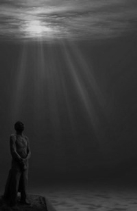题目内容
Mo Yan, ____ famous contemporary Chinese writer, this year’s Nobel Prize winner for literature, abandons _____conventional writing style and advocates his unique way of Magic Realism.
A.the; a B. a; the C. a; a D. the; the
B
【解析】
试题分析:本题考察的是定冠词和不定冠词表示特指和泛指的用法。第一空后面的名词writer是一个可数名词,故前面使用a表示泛指一位著名的当代作家;第二空名词style前面有形容词修饰,说明该词表示的是特指,使用定冠词the。故B正确。
考点:考察冠词

The following are the sculptures in the Underwater Museum, which are | |
| The Archive of Lost Dreams The Visual: It describes an underwater archive of messages in bottles. The Meaning: The bottles contain messages of dreams for future generations. The Hope: The statue is placed with the purpose of helping draw visitors away from the healthy parts of the reef. The Location: The Archive of Lost Dreams was placed 8 meters deep at Manchones Reef, close to Isla Mujeres. Behind the Scenes: The collection of bottled messages were provided by various communities who wrote about today’s values and their dreams for the future generations. |
| The Gardener of Hope The Visual: Here a young Mexican girl lies in a garden surrounded by pots which will be grown with live coral. The Meaning: The young girl in the sculpture represents a model for hopeful future generations. The Hope: The base of the Gardener of Hope was built to attract various marine creatures. The coral in the pots is also expected to grow. The Location: The Gardener of Hope was placed 4 meters deep at Punta Nizuc near the coast of Cancun. Behind the Scenes: The pots here are filled with live coral cuttings that were saved from areas of the local reef system. |
| Man on Fire The Visual: Man on Fire describes a lone male figure covered in live fire coral to resemble fire. The Meaning: The sculpture symbolizes the unawareness of the “fire” our generation has started with the over use of limited natural resources. The Hope: Man on Fire has 75 holes planted with small live cuttings of fire coral which are expected to grow like fire. The Location: Man on Fire was installed 8 meters deep at the Manchones Reef nearby to Isla Mujeres. Behind the Scenes: The sculpture was cast from a local Mexican fisherman and it weighs over 1 ton. |
| The Silent Evolution The Visual: Here more than 400 sculptures depict the timeline of human nature. The Meaning: It is a documentation of how society and people have changed over time. It is also to remind us of how we are connected to nature. The Hope: The installation is designed for forming a complex reef structure that marine life will claim as its own and inhabit. The Location: The Silent Evolution will be installed 8 meters deep behind the Manchones Reef. Behind the Scenes: The total installation will expand over 150 square meters and will weigh over 120 tons. |
Attention: Guided tours are a must. You can catch a tour from Aquaworld, which leaves every hour from 9 a.m. to 3 p.m. daily. | |
1.Which of t he following is true according to the passage?
he following is true according to the passage?
A. You can tour individually without a tourist guide by glass boat.
B. The Gardener of Hope will remind us of the relationship with nature.
C. Bottled messages are filled with live coral cuttings for future generations.
D. Man on Fire can educate us to protect the limited natural resources.
2.Which sculptures are installed in the same area?
A. Man on Fire & The Silent Evolution
B. The Archive of Lost Dreams & Man on Fire
C. The Gardener of Hope & The Silent Evolution
D. The Archive of Lost Dreams & The Gardener of Hope
3.The writer introduces the sculptures to _______.
A. defend Mexican Tourism Industry
B. call on us to go on a tour to Aquaworld
C. appeal to readers to protect Marine Life
D. attract tourists to the Underwater Museum
 accessible in person by glass boat, or scuba diving.
accessible in person by glass boat, or scuba diving. 


